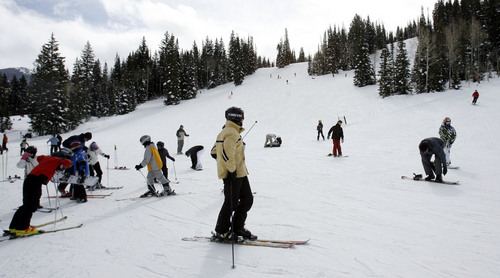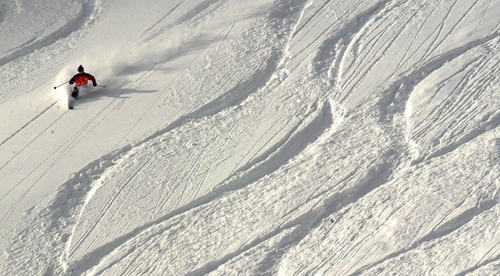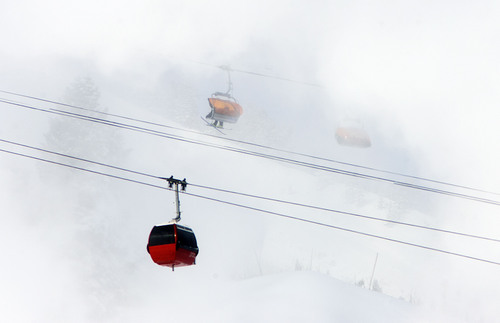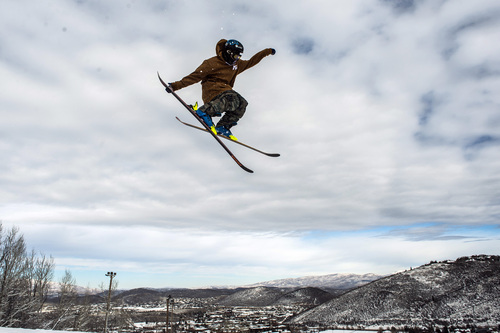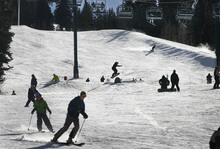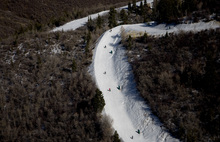This is an archived article that was published on sltrib.com in 2014, and information in the article may be outdated. It is provided only for personal research purposes and may not be reprinted.
Ski Utah is offering a few more details about where lifts would be needed to make One Wasatch, its plan for interconnecting the seven Wasatch Mountain ski resorts, a reality.
Two sets of lifts are envisioned in a conceptual plan to be released Tuesday, said Nathan Rafferty, president and CEO of Ski Utah, marketing arm for the state's ski industry.
The first set, connecting Little Cottonwood and Big Cottonwood canyons, would require Alta Ski Area to install a lift up Grizzly Gulch to the ridgeline, where it would hook up with a lift coming up Honeycomb Canyon from Solitude Mountain Resort.
The connection between Big Cottonwood and the Park City side of the Wasatch would take place in the Guardsman Pass area. One lift would make it possible for riders coming from Brighton's Great Western lift to reach Park City Mountain Resort, while the other would help transport skiers and snowboarders from PCMR's Jupiter Bowl area over to Brighton.
This latest plan does away with the proposed Ski Link hookup between Solitude and Canyons Resort.
Conservationists and backcountry skiers reviled Ski Link as a precursor to the interconnect plan, in part because it opened up hard-to-access terrain to people riding lifts. But Ski Link has been on the backburner for more than a year, ever since Canyons Resort turned its attention instead to acquiring PCMR.
Because of the unresolved litigation in that fight, the new design does not address a connection between Canyons and PCMR, physically the easiest to do. No connection may be necessary if Canyons prevails in that lawsuit.
A 3rd District judge gave PCMR until Friday to post a $17.5 million bond that would keep the resort going through the upcoming season while PCMR appeals an earlier ruling upholding Canyons' ability to evict it for failing to renew a mountainside lease on time.
The other three connections — between Deer Valley and PCMR, Brighton and Solitude, and Alta and Snowbird — already are in place.
"Connecting seven of Utah's finest ski resorts while preserving both our water quality and an unrivaled backcountry experience is not an impossible task," Rafferty said Monday.
"We have decided to move a step forward in the vision process by conceptualizing lift alignments on a map to continue providing information to the public, encouraging dialogue and listening to feedback about these possible connections," he added, noting that a Ski Utah survey also showed solid public support for the interconnect idea.
Ski Utah sent a short survey to 35,000 online subscribers to its monthly newsletter or daily snow reports, receiving more than 3,000 back. Of those, 45 percent think an interconnect is a great idea, while another 28 percent said it was somewhat good. About 19 percent of respondents thought One Wasatch was a somewhat or very bad idea.
Neither the lift alignments nor the survey results surprised Save Our Canyons Executive Director Carl Fisher, nor did they diminish his objections to the concept.
"If we did a poll of our membership, we would find that 90 percent want to see wilderness expanded through the Wasatch Mountains," he said. "Polls aren't very conclusive when you're not polling an objective portion of the community."
Fisher said the lift alignments around Guardsman Pass and between the Cottonwood canyons were relatively easy to predict. The most troublesome part to him involves Alta's plan for Grizzly Gulch, which he believes would require an amendment to the U.S. Forest Service master plan.
"That is not something we would support at all," Fisher said. "The plan says the ski resorts in their existing configuration is adequate. We agree with that."
At present, the Grizzly Gulch lift is contemplated to go over a parcel of Forest Service property that is not part of Alta's special use permit, which would require extra environmental analysis.
That doesn't concern Alta General Manager Onno Wieringa, noting he has spent years talking to the Forest Service about Grizzly Gulch's potential and challenges.
"The Forest Service likes us to do what makes the most sense, to have the best alignment that works for people and not to do convoluted things," Wieringa said. "This makes the best sense to us. We'll see if we can work something out with the Forest Service."
He likes Rafferty's plan to submit the concept to Mountain Accord, a broad-based public and private effort trying to determine how best to treat the popular central Wasatch Mountains in a more heavily populated future.
"They have so many people involved and they're really good at getting people to put their cards on the table and say 'this is what we're thinking.' I would like to think that the recommendations [Mountain Accord] comes up with will be looked at by the Forest Service as a good public process," Wieringa said.
Fisher also thinks Mountain Accord is a good forum to vet interconnect issues.
"It's certainly more inclusive, definitely a more robust process," he said. "Mountain Accord has its issues. It's trying to bite off a whole lot and it's a little overwhelming. But it's a pretty good venue."
No timetable has been set for development, Rafferty said.
Twitter: @sltribmikeg —
Additional information about the interconnect proposal is available at http://www.ONEWasastch.com.



